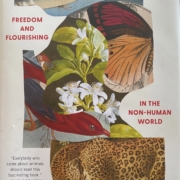 Wild Souls: Freedom and Flourishing in the Non-Human World, a new book with a groundbreaking and provocative vision for our relationships with–and responsibilities toward–the planet’s wild animals by acclaimed environmental writer, Emma Marris, is now available on Amazon.
Wild Souls: Freedom and Flourishing in the Non-Human World, a new book with a groundbreaking and provocative vision for our relationships with–and responsibilities toward–the planet’s wild animals by acclaimed environmental writer, Emma Marris, is now available on Amazon.
Protecting wild animals and preserving the environment are two ideals so seemingly compatible as to be almost inseparable. But in fact, between animal welfare and conservation science there exists a space of underexamined and unresolved tension: wildness itself. When is it right to capture or feed wild animals for the good of their species? How do we balance the rights of introduced species with those already established within an ecosystem? Can hunting be ecological? Are any animals truly wild on a planet that humans have so thoroughly changed? No clear guidelines yet exist to help us resolve such questions.
Transporting readers into the field with scientists tackling these profound challenges, Emma Marris tells the affecting and inspiring stories of animals around the globe–from Peruvian monkeys to Australian bilbies, rare Hawai’ian birds to majestic Oregon wolves. And she offers a companionable tour of the philosophical ideas that may steer our search for sustainability and justice in the non-human world. Revealing just how intertwined animal life and human life really are, Wild Souls will change the way we think about nature-and our place within it.

KFBRP Scientists are transported to the Alaka’i Plateau by Helicopter
And just who are these scientists that transport the readers (and the author) into the field? They are not just fabrications of fiction writing. In the chapter titled, “The Flight of the ‘Akikiki”, a small curly haired woman emerges from a car and hands off a flight suit to the author. That scientist is none other than KFBRP’s leader, Lisa “Cali” Crampton. Her mission: saving Kauai’s Forest Birds from the “abyss of extinction”. The readers are then transported by means of a red helicopter lacking doors into the depths of the Alaka’i.
It is significant to note that the author was inspired to include a whole chapter dedicated to plight of Hawaiian forest birds, some of which may face imminent extinction. She contrasts a time when Hawaiians trapped the birds to fashion feather cloaks for royalty. Some may speculate that this act alone contributed to the demise of these species, but the fact is that the Hawaiian understood nature in a way where they could interact with the birds in a sustainable manner, taking only 2 or 3 feathers before releasing the birds back into their habitat. This concept is largely forgotten today. Hawaiians recognized the value of each species and its role in the overall health of the environment. This is how the scientists at KFBRP view the species as well, each with an important role maintaining the balance within the forest ecosystem.
If you care about animals and nature, this book will provide you with a new perspective on nature and its wild souls.

Lisa “Cali” Crampton in the field with Emma Marris, author of Wild Souls









